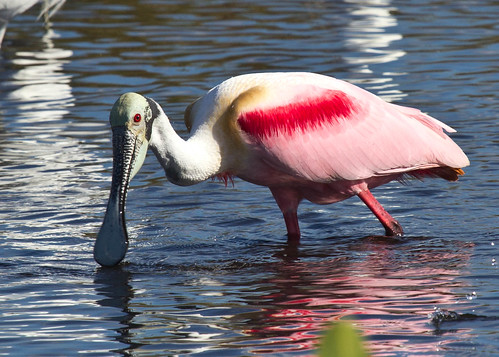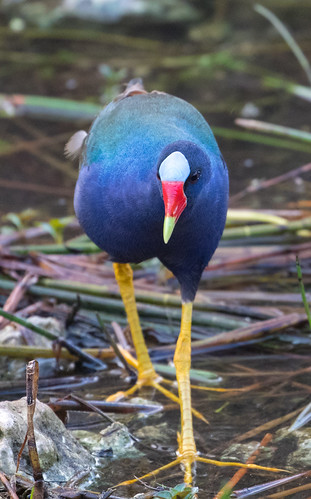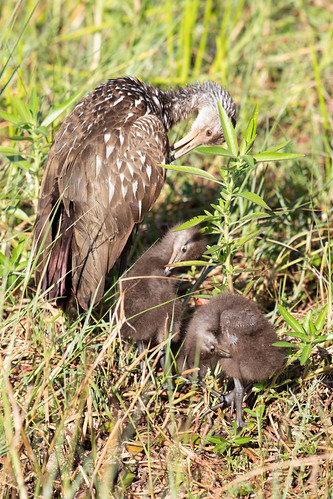My older son lives in Florida, so Russ and I have been making regular trips there for two decades. If I had one favorite bird there, it would be the endemic Florida Scrub-Jay, a species not found anywhere on the planet outside of Florida, but there are so many other favorites that I could never compile a top-ten list. I mean, Roseate Spoonbills!
Wood Storks!
Purple Gallinules!
Anhingas!
Limpkins!
Mangrove Cuckoos in spring and summer!
Northern Gannets in winter!
The Great White Heron—either a unique Everglades form of our familiar Great Blue Heron or a different species depending on which evolutionary biologist you talk to, but a cool bird nonetheless.
Parula Warblers in Florida nest in Spanish moss—those here in Minnesota nest in the sort-of-similar-looking but entirely unrelated “old man’s beard” lichens.
Those all sprung to mind instantly, before I even started to think about stunning Yellow-throated Warblers, Prairie Warblers, Red-cockaded Woodpeckers, Bachman’s Sparrows, Least Bitterns, Reddish Egrets, Loggerhead Shrikes, Boat-tailed Grackles. And oh, gosh—Swallow-tailed Kites!
Florida’s birds are far from their only natural features so entirely different from what we experience in the Upper Midwest. Alligators are always thrilling to see, somehow even more so when we get to hear adult males bellowing.
I’ve seen American crocodiles in Costa Rica and, in 2019, in Panama, and over the years, have seen with yearning warning signs about crocodiles down in the Everglades, but never had seen a wild alive crocodile in Florida until Russ and I were down in Flamingo at the southern end of Everglades National Park in 2018. This endangered species of coasts, mangrove swamps, and brackish lakes is adapted to high salinity, unlike its alligator cousin.
Everywhere you go in Florida, there are reptiles—lizards and geckos and snakes abound. The only water moccasin I’ve seen in Florida was basking on a rock near the Pirates of the Caribbean ride at Disney World, but I heard rattlesnakes when I was walking along the Snake Bight Trail in the Everglades. The trail name isn’t spelled “b-i-t-e” but “b-i-g-h-t,” referring to a bay within a larger bay—the bay called Snake Bight is within Florida Bay. Actually, it was at least two different rattlesnakes I heard lurking in the leaf litter when I was hiking alone there in November 1988, plenty enough to make me stay carefully on the trail and keep my eyes directed to the ground around and ahead of me. On the way back, I came upon a huge alligator hunkering down completely blocking the trail. I didn’t know what to do. I didn’t want to step off the trail into that leaf litter to begin with, plus I didn’t know which end of the alligator would be the safer one to pass—the end with all the teeth or the end with the powerful tail capable of not just knocking a person over but breaking their legs on the way down. I knew Russ and the kids were waiting for me in the car on the road still a half mile ahead of me, and when I finally grew desperate, I tossed a few little stones on the alligator’s back. It lifted up on those squat legs and finally sauntered away.
Memorable as that experience was, something even more memorable happened on that walk along the Snake Bight Trail: I saw my lifer Mangrove Cuckoo! It was perched, holding stock still along a large limb. Because I was mostly looking down making sure there weren't snakes underfoot, I’d never have noticed it at all except that a flock of Blue-gray Gnatcatchers was mobbing it, scolding insistently. Even then, the cuckoo held so still that I wouldn’t have believed my eyes had I not clearly seen it blink a couple of times.
I’ve had too many wonderful birding experiences in Florida to even begin to recount them. That 1988 Snake Bight Trail adventure happened long before I was photographing birds, but since 2005, I’ve been photographing and sometimes videorecording a lot of the creatures I’ve seen. Seeing Florida so often these past three decades has been both wonderful and heartbreaking. Next time: the dark side of Florida.













